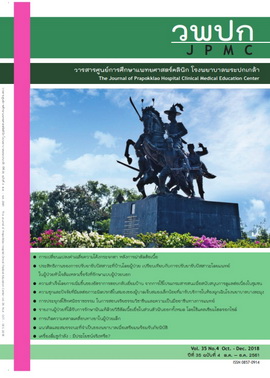Changes in mean corneal keratometry readings after pterygium excision surgery
Main Article Content
Abstract
Background: Pterygium affects corneal curvature and consequently could affect intraocular lens calculation.
Objective: To study the effect of changes in average curvature of the central cornea after pterygium excision.
Materials and methods: This study is a descriptive analysis. Review of the history of patients with primary pterygium treated by the same ophthalmologist in the Department of Ophthalmology, Chaophraya Abhaibhubejhr Hospital was carried out from July 2014 to January 2018. All patients had preoperative and postoperative corneal keratometry readings (Canon RK-5).
Results: Forty-eight patients with pterygium were included in the study. The mean age of the 21 men and 27 women in the study was 58.2 years. The mean horizontal pterygium length was 2-8 millimeters. The mean corneal keratometry readings after pterygium surgery were significant from 43.51 diopters to 44.74 diopters and 44.38 diopters at 2 weeks and 3 months, respectively (Friedman Test, p < 0.001)
Conclusion: The postoperative mean corneal keratometry readings were significantly different compared to preoperative values.
Article Details
References
1.Shtein RM, Sugar A. Pterygium and conjunctival degenerations. In: Yanoff M, Duker JS, editors. Ophthalmology. 4th ed. China: Saunders; 2014. p 203-5.
2.Tan DTH, Chong EW. Management of pterygium. In: Mannis MJ, Holland EJ, editors. Cornea. 4th ed. China: Elsevier; 2017. p 1560-72.
3.Lei L, Wu J, Geng J, Yuan Z, Huang D. Geographical prevalence and risk factors for pterygium: a systematic review and meta-analysis. BMJ Open [Internet]. 2013[cited 2018 May 2]; 3(11):e003738. Avialable from: https://bmjopen.bmj.com/content/bmjopen/3/11/e003787.full.pdf
4.Mackenzie FD , Hirst LW, Battistutta D, Green A. Risk analysis in the development of pterygia. Ophthalmology 1992; 99(7): 1056-61.
5.Rezvan F, Khabazkhoob M, Hooshmand E, Yekta A, Saatchi M, Hashemi H.Prevalence and risk factors of pterygium:a systematic review and meta-analysis. Surv Ophthalmol 2018; 63:719-35.
6.Kwok LS, Coroneo MT. A model for pterygium formation. Cornea 1994;13: 219-24.
7.Errais K, Bouden J, Mili-Boussen I, Anane R, Beltaif O, Meddeb Ouertani A. Effect of pterygium surgery on corneal topography. Eur J Ophthalmol. 2008; 18:177-81.
8.Oltulu R, Demirel S, Sarac O, Ozer MD.Evaluation of corneal and anterior chamber changes following pterygium surgery using a pentacamscheimplug system: a prospective study. SeminOphthalmol 2013; 28:206-9.
9.Cinal A, Yasar T, Demirok A, Topuz H. The effect of pterygium surgery on corneal topography. Ophthalmic Surg Lasers 2001; 32: 35-40.
10.Kim SW, Park S, Im CY,Seo KY, Kim EK. Prediction of mean corneal power change after pterygium excision. Cornea 2014; 33:148-53.
11.Kheirkhah A, Safi H, Molaei S, Nazari R, Behrouz MJ, Raju VK. Effects of pterygium surgery on front and back corneal astigmatism. Can J Ophthalmol 2012; 47: 423-8.
12.Kam KW, Kuan TA, Belin MW, Young AL. Long-term stability of keratometry, scheimpflug-derived true net power, and total corneal refractive power after primary pterygium excision. Cornea 2017; 36:1358–63.
13.Koc M, Uzel MM, Aydemir E, Yavrum F, Kosekahya P, Yılmazbaş P.Pterygium size and effect on intraocular lens power calculation. J Cataract Refract Surg 2016; 42:1620-25.
14.Ibechukwu BI. Simultaneous pterygium and intraocular surgery. Br J Ophthalmol 1990; 74: 265-6.
15.Sophonthanruk S. Astigmatism visual outcome and complication of small incision extracapsular cataract extraction using the anterior chamber maintainer in mature cataract. J PrapokklaoHospClin Med Educat Center 2006:202-8.

